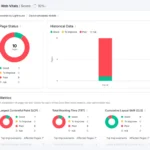
In today’s digital era, mobile devices dominate online traffic. People browse, shop, and search on their phones more than ever before. In response to this shift, Google introduced Mobile-First Indexing, a major transformation in how websites are ranked and indexed.
Understanding mobile-first indexing isn’t optional anymore—it’s essential for SEO success. Let’s explore what it means, how it affects your rankings, and how to optimize your website for this new standard.
What Is Mobile-First Indexing?
Mobile-first indexing means that Google primarily uses the mobile version of your website for indexing and ranking. Previously, Google’s algorithms used the desktop version to determine ranking signals. However, as mobile traffic grew, this model became outdated.
Now, if your website’s mobile experience is poor, it could significantly impact your visibility—even if your desktop site looks great.
Why Google Moved to Mobile-First Indexing
The shift wasn’t just a technical change—it reflected user behavior.
- Over 60% of global searches now happen on mobile devices.
- Google wants users to have a consistent, positive experience across devices.
- Mobile-first indexing ensures mobile-friendly sites get preference in rankings.
In simple terms: If your site isn’t optimized for mobile, it’s losing SEO opportunities.
How Mobile-First Indexing Impacts SEO
1. Content Consistency Is Crucial
Your mobile and desktop versions must contain the same content. If your mobile site has less text, fewer images, or missing structured data, Google may not index or rank that missing information.
Tip: Use a responsive design that automatically adjusts the layout while keeping content identical across devices.
2. Mobile Page Speed Affects Rankings
Mobile users expect fast-loading pages. Google’s Core Web Vitals—especially Largest Contentful Paint (LCP), First Input Delay (FID), and Cumulative Layout Shift (CLS)—are all measured on mobile devices.
Optimization tips:
- Compress images without losing quality.
- Minify CSS, JavaScript, and HTML.
- Use a reliable CDN (Content Delivery Network).
3. Structured Data Must Match on Both Versions
Structured data (schema markup) helps Google understand your content. Make sure schema tags and metadata are identical across desktop and mobile versions to avoid misindexing or ranking loss.
4. Responsive Web Design Boosts SEO
Google recommends responsive design over separate mobile URLs (like m.example.com). Responsive sites are easier to crawl, faster to update, and deliver a consistent user experience across devices.
5. Navigation and User Experience (UX) Matter
Mobile users interact differently than desktop users. Your site navigation should be:
- Simple and intuitive.
- Free of intrusive pop-ups.
- Optimized with readable fonts, tappable buttons, and clear menus.
A better UX reduces bounce rates—an indirect but vital SEO factor.
6. Internal Linking and Crawlability
Sometimes, mobile sites use different link structures or fewer internal links, making it harder for Google’s bots to crawl the entire website.
Ensure that internal links are consistent, allowing crawlers to reach every important page.
7. Optimize for Mobile Search Intent
Mobile searches are often voice-driven and location-based (e.g., “restaurants near me”).
Incorporate conversational keywords, local SEO optimization, and structured data like reviews, ratings, and business hours to match mobile intent.
How to Check if Your Website Is Ready for Mobile-First Indexing
Use these tools to test readiness:
- Google’s Mobile-Friendly Test – checks usability and design on mobile.
- Google Search Console – verifies which version Googlebot is crawling.
- PageSpeed Insights – provides insights on mobile loading performance.
If your site isn’t mobile-optimized yet, Google will still index it, but your ranking potential will drop compared to mobile-ready competitors.
The Future of SEO in a Mobile-First World
As mobile usage continues to dominate, the future of SEO will be experience-driven rather than just keyword-driven. Websites that provide speed, accessibility, and seamless user experiences will consistently outperform competitors.
AI-driven search, visual search, and voice optimization will continue to evolve around mobile behavior—so optimizing for mobile is no longer a trend, it’s the foundation of modern SEO.
Our Services SEO Services in Hitech City | SEO Services in Kukatpally | SEO Services in Gorakhpur | SEO Services in Ranchi
Key Takeaways
- Google now indexes and ranks sites based on their mobile version first.
- Responsive design, speed optimization, and content parity are non-negotiable.
- A great mobile experience equals better rankings, engagement, and conversions.
- Always think “mobile-first” when designing, publishing, and optimizing content.
FAQs
1. Does Google still use desktop sites for indexing?
In most cases, no. Google now relies almost entirely on the mobile version for crawling and indexing. Only a few older sites without mobile versions may still be indexed via desktop.
2. What happens if my mobile site is incomplete?
If your mobile version lacks important pages or data, Google may not index that missing content, causing ranking drops—even if the desktop version is complete.
3. Should I remove my desktop site completely?
No, keep both versions. The goal is to ensure that your desktop and mobile experiences are consistent, not identical in layout but equal in content and functionality.
4. How can I improve my mobile crawl rate?
Use XML sitemaps, submit them in Google Search Console, and ensure that your robots.txt file doesn’t block important mobile resources like CSS or JS files.
5. Does mobile-first indexing affect backlinks?
Indirectly. If your mobile pages load slowly or display broken links, Google may view them as poor-quality. However, your link equity remains the same if the URLs are consistent.
6. Is AMP (Accelerated Mobile Pages) still necessary?
Not mandatory. While AMP once boosted speed and visibility, modern responsive designs with good Core Web Vitals performance can now match or exceed AMP efficiency.
7. How often should I test mobile performance?
Regularly. Test monthly or after any design update to ensure new scripts, plugins, or visuals don’t slow your mobile load speed or affect usability.
Conclusion
Mobile-first indexing has changed the entire landscape of SEO. Success now depends on how well your site performs on mobile—its speed, structure, and user experience.
By ensuring your mobile site matches your desktop in content, provides seamless usability, and loads quickly, you’ll be aligned with Google’s mobile-first vision—and stay ahead of competitors in the ever-evolving digital world.





